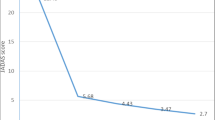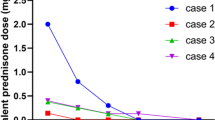Abstract
Introduction
Juvenile idiopathic arthritis (JIA) is a heterogeneous group of idiopathic inflammatory arthritis affecting children younger than 16 years of age. Tocilizumab (TCZ) is a humanized anti-interleukin 6 (IL-6) receptor antibody that was approved for systemic and polyarticular JIA patients. However, the studies regarding patients’ satisfaction while receiving TCZ therapy is scarce. Herein, we aimed to evaluate the effect of subcutaneous (SC) TCZ administration on patient satisfaction and disease control of JIA patients.
Methods
All JIA patients receiving TCZ were included in the study. Clinical features, laboratory findings and JADAS71 scores were recorded at baseline and every 3 months during follow-up. Nine of the patients on intravenous (IV) TCZ treatment were switched to SC form. All patients receiving TCZ-SC were questioned by a clinical nurse specialist (CNS) to assess patient satisfaction.
Results
A total of 39 patients receiving TCZ were included in the study. Among them, treatment of nine patients (five female, four male) was switched to SC form with a median of 11.5 (8–69) months after initiation of TCZ. Patients were stable both clinically and in laboratory means at the 3rd month of TCZ-SC treatment. There was no deterioration in terms of active joint counts, physician’s VAS, patient’s VAS and JADAS71. According to patient satisfaction questionnaire, eight of the patients felt satisfied with SC administrations in terms of life quality, school success and reduced school absenteeism. However, one patient did not agree that the SC form is as effective as IV form and wanted to continue with IV form.
Conclusion
TCZ is an effective treatment option in JIA and switching from IV to SC route when necessary is found to be an effective and acceptable alternative by the patients as well.
Similar content being viewed by others
References
Ringold S, Weiss PF, Beukelman T et al (2013) 2013 update of the 2011 American College of Rheumatology recommendations for the treatment of juvenile idiopathic arthritis: recommendations for the medical therapy of children with systemic juvenile idiopathic arthritis and tuberculosis screening among children receiving biologic medications. Arthritis Rheum 65:2499–2512
Beukelman T, Patkar NM, Saag KG et al (2011) 2011 American College of Rheumatology recommendations for the treatment of juvenile idiopathic arthritis: initiation and safety monitoring of therapeutic agents for the treatment of arthritis and systemic features. Arthritis Care Res (Hoboken) 63:465–482
Ringold S, Weiss PF, Colbert RA et al (2014) Childhood arthritis and rheumatology research alliance consensus treatment plans for new-onset polyarticular juvenile idiopathic arthritis. Arthritis Care Res (Hoboken) 66:1063–1072
Mallalieu NL, Wimalasundera S, Hsu JC et al (2019) Intravenous dosing of tocilizumab in patients younger than two years of age with systemic juvenile idiopathic arthritis: results from an open-label phase 1 clinical trial. Pediatr Rheumatol Online J 17:57
Ringold S, Angeles-Han ST, Beukelman T et al (2019) 2019 American College of Rheumatology/Arthritis Foundation Guideline for the Treatment of Juvenile Idiopathic Arthritis: Therapeutic Approaches for Non-Systemic Polyarthritis, Sacroiliitis, and Enthesitis. Arthritis Care Res (Hoboken) 71:717–734
Ogata A, Kato Y, Higa S, Maeda K (2019) Subcutaneous tocilizumab: recent advances for the treatment of rheumatoid arthritis. Expert Opin Drug Deliv 16:639–648
Petty RE, Southwood TR, Manners P et al (2004) International League of Associations for Rheumatology classification of juvenile idiopathic arthritis: second revision, Edmonton, 2001. J Rheumatol 31:390–392
Consolaro A, Ravelli A (2016) Defining criteria for disease activity states in juvenile idiopathic arthritis. Rheumatology (Oxford) 55:595–596
McErlane F, Beresford MW, Baildam EM et al (2013) Validity of a three-variable Juvenile Arthritis Disease Activity Score in children with new-onset juvenile idiopathic arthritis. Ann Rheum Dis 72:1983–1988
Consolaro A, Ruperto N, Bazso A, Pistorio A, Magni-Manzoni S, Filocamo G, Malattia C, Viola S, Martini A, Ravelli A, Paediatric Rheumatology International Trials O (2009) Development and validation of a composite disease activity score for juvenile idiopathic arthritis. Arthritis Rheum 61:658–666
Dashiell-Aje E, Harding G, Pascoe K, DeVries J, Berry P, Ramachandran S (2018) Patient evaluation of satisfaction and outcomes with an autoinjector for self-administration of subcutaneous belimumab in patients with systemic lupus erythematosus. Patient 11:119–129
De Benedetti F, Brunner HI, Ruperto N et al (2012) Randomized trial of tocilizumab in systemic juvenile idiopathic arthritis. N Engl J Med 367:2385–2395
Brunner HI, Ruperto N, Zuber Z et al (2015) Efficacy and safety of tocilizumab in patients with polyarticular-course juvenile idiopathic arthritis: results from a phase 3, randomised, double-blind withdrawal trial. Ann Rheum Dis 74:1110–1117
Curtis JR, Schabert VF, Harrison DJ, Yeaw J, Korn JR, Quach C, Yun H, Joseph GJ, Collier DH (2014) Estimating effectiveness and cost of biologics for rheumatoid arthritis: application of a validated algorithm to commercial insurance claims. Clin Ther 36:996–1004
Atkinson MJ, Sinha A, Hass SL, Colman SS, Kumar RN, Brod M, Rowland CR (2004) Validation of a general measure of treatment satisfaction, the Treatment Satisfaction Questionnaire for Medication (TSQM), using a national panel study of chronic disease. Health Qual Life Outcomes 2:12
Desplats M, Pascart T, Jelin G, Norberciak L, Philippe P, Houvenagel E, Goeb V, Flipo RM (2017) Are abatacept and tocilizumab intravenous users willing to switch for the subcutaneous route of administration? A questionnaire-based study. Clin Rheumatol 36:1395–1400
Rush ET, DeHaai K, Kreikemeier RM, Lutz RE (2012) Evaluation and comparison of safety, convenience and cost of administering intravenous pamidronate infusions to children in the home and ambulatory care settings. J Pediatr Endocrinol Metab 25:493–497
Lechanska-Helman J, Sobocinska A, Jerzynska J, Stelmach I (2020) The influence of hospital-based intravenous immunoglobulin and home-based self-administrated subcutaneous immunoglobulin therapy in young children with Primary Immunodeficiency Diseases on their parents/caregivers satisfaction. Pediatr Int 62:316–318
Odinet JS, Day CE, Cruz JL, Heindel GA (2018) The biosimilar nocebo effect? A systematic review of double-blinded versus open-label studies. J Manag Care Spec Pharm 24:952–959
Huynh TK, Ostergaard A, Egsmose C, Madsen OR (2014) Preferences of patients and health professionals for route and frequency of administration of biologic agents in the treatment of rheumatoid arthritis. Patient Prefer Adher 8:93–99
Sylwestrzak G, Liu J, Stephenson JJ, Ruggieri AP, DeVries A (2014) Considering patient preferences when selecting anti-tumor necrosis factor therapeutic options. Am Health Drug Benefits 7:71–81
Quesada-Masachs E, Caballero CM (2017) Subcutaneous tocilizumab may be less effective than intravenous tocilizumab in the treatment of juvenile idiopathic arthritis-associated uveitis. J Rheumatol 44:260–261
Acknowledgements
We sincerely thank to Begüm Ayaz for kind help while writing the draft manuscript.
Funding
None.
Author information
Authors and Affiliations
Contributions
NAA conceptualized and designed the study, drafted the initial manuscript, and had full access to all the data in the study; SGK, RK, FGD, FÇ, and HES designed the study, conducted the data analyses, drafted the initial manuscript, and had full access to all the data in the study. All authors reviewed and revised the manuscript and approved the final version of the manuscript. Congress abstract publications: None.
Corresponding author
Ethics declarations
Conflict of interest
The authors have declared no conflicts of interest. None of the authors had relationships with pharm agencies.
Ethical approval
The study was reviewed and approved by the local ethical review committee (Ethics approval number: KAEK/2019.01.06). Written informed consents were signed by parents and patients.
Additional information
Publisher's Note
Springer Nature remains neutral with regard to jurisdictional claims in published maps and institutional affiliations.
Electronic supplementary material
Below is the link to the electronic supplementary material.
Rights and permissions
About this article
Cite this article
Ayaz, N.A., Karadağ, Ş.G., Koç, R. et al. Patient satisfaction and clinical effectiveness of switching from intravenous tocilizumab to subcutaneous tocilizumab in patients with juvenile idiopathic arthritis: an observational study. Rheumatol Int 40, 1111–1116 (2020). https://doi.org/10.1007/s00296-020-04596-3
Received:
Accepted:
Published:
Issue Date:
DOI: https://doi.org/10.1007/s00296-020-04596-3




